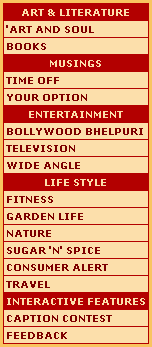 |
 |
IF I write this on the unlikely theme of embroideries, it is because teaching tools, of whatever kind they are, interest me. Among the most engaging, and delightful, of these that I have come upon recently is the gallery dedicated to embroidery techniques, which has come up recently at the famed Calico Museum of Textiles inAhmedabad. I know remarkably little about the subject, but I was completely drawn into it, artefact by artefact, showcase by instructive showcase, that fills the gallery. It occupies a realitively small space, but the manner in which it is organised — using a fine blend of clarity and imagination — takes one straight to the heart of the matter, like much else in that remarkable museum, Imight add.At the end, even the most disinterested, or uninformed, visitor leaves feeling close to the subject, richer by the experience of having been inside that space.
|
|||||||||
| I am reasonably certain that, before she
came to India,Anne Morrell knew something, but not a
great deal, about Indian embroideries. But, once here,
and having accepted the challenge of setting up a gallery
showcasing only Indian embroidery techniques, she seems
to have immersed herself in the subject, doing fieldwork,
garnering information, placing it first in a defined
local context, and then relating it to the wider field of
embroideries from other lands. This is what gives to her
work a keen edge and a sense of great clarity. The way in
which she has gone about explaining techniques used in
the wide range of Indian embroideries is remarkably
simple, on the one hand, and highly instructive, on the
other. All the stitches broadly identified and explained,
she takes a complex piece of embroidery — one of
those exquisitely colourful cholis or kanchalis
from Gujarat, for example — and makes a panel, very
large and clear, showing, greatly magnified, every single
stitch used in the embroidery, and relating it to the
parts of the garment on which it has been used.What one
almost does not see on the garment, for it is so tightly
and artfully done, one begins to see clearly on her
enlarged technique panel: chain stitch, reverse chain
stitch, open chain stitch, laid work. Cretan stitch,
Romanian stitch, and so on. The stitches come alive, but
so does, with them, the garment itself, the viewer
suddenly beginning to see it with a new respect on
account of the sheer dexterity with which it was done. Anne Morrell’s work is not confined toGujarat, even though the Calico Museum is located in Ahmedabad and has a vast number of textiles and garments from the surrounding region.She casts her net much wider, and within her ken are all embroidery techniques followed in India. That is how one sees objects as different, and as visually exciting, as Chamba rumals and Punjab phulkaris and Bengal kanthas and techniques as wide-ranging as mirror-work and patchwork and applique, and materials as varied as metal-threads and sequins and leather and cowrie-shells, apart, naturally, from cotton and silk and wool. Within the gallery, one travels in all directions, traverses great distances. As I said, I know truly little about the subject. That embroidery was done in India, from very early times indeed, is something everyone knows about. If from nothing else, from the patterned wrap that the famous bust of a yogi fromMohenjodaro carries, and from elaborate references to those enticingly beautiful ‘flowered muslins’ that Greek geographers described in their 4th to 3rd century BC accounts. But techniques are another matter, and it is in these that one sees reflections of contacts and commonness. The Cretan or the Romanian stitches used routinely by Indian embroiderers, naturally under different, local names, are relatively simple examples.How the same stitches — some of them very complex and regard as unique to themselves by the people of one region — are used in different regions of the world, separated by history and by great distances, gives one something to think about. Other connections Speaking of embroideries, my mind turns somewhat naturally towards embroideries close to home.Among the finest work seen in this region was done in the hills, as seen in the Chamba rumals, so-called because similar work was done in a much wider region than represented by that state alone. The technique seen in them is highly refined, the embroidery being double-sided so that the pattern appears exactly the same on both sides. In their connection, incidentally, find mentioning two things hard to resist. One, the close connection between these pictorial textiles and Pahari paintings by which they are inspired. The two seem to be sahodara, ‘born of the same womb’, as it were, sharing not only themes but also a vision. The second: I am reminded, each time I see a Chamba rumal, of T.S. Eliot. For it was he, Ibelieve, who said — speaking of the natural inadequacy of translations — that all translation is like looking at the reverse of an embroidery. Clearly, he had never seen a Chamba rumal in his life! |